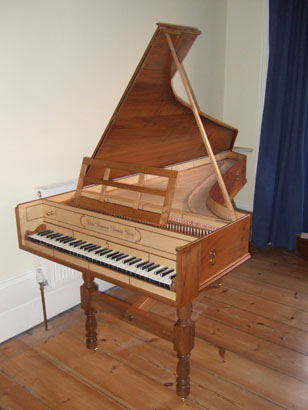Harpsichord after William Smith
The case, including the spine, is made of English walnut, veneered inside with maple, with decorative inlaid lines. There is a single manual with a compass of 5 octaves from GG to g''' (with the ability to transpose to either A440 or 415), naturals covered with camel bone, and 'skunk-tail' sharps. There are two 8foot registers strung in brass. The sound is full and characterful, the back register sweet and singing, and the front more pungent, and with a particularly good treble on both. Though not the chimerical “universal harpsichord”, it is nevertheless suited to a very wide range of music, perhaps reflecting that which was available in London in the early 18th century. This harpsichord is a good example of the English style in the period before that in which it came to be dominated by Kirckman and Shudi and their various imitators.
